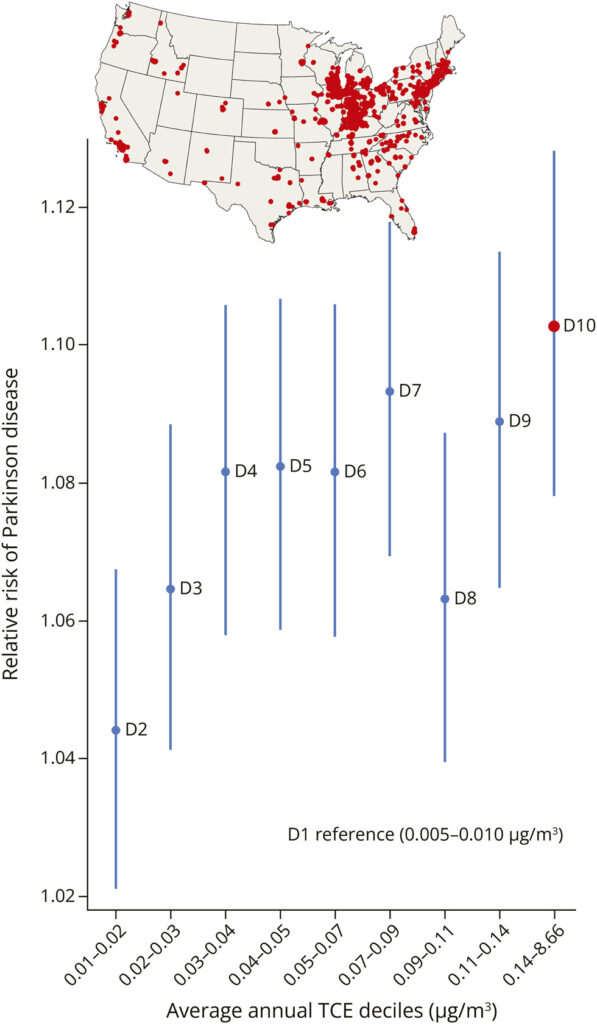
Ambient TCE Exposure Suggests Link to Parkinson’s Disease Risk Nationwide
(PHOENIX – Oct. 1, 2025) – A pioneering study by researchers at Barrow Neurological Institute at Dignity Health St. Joseph’s Hospital and Medical Center suggests a potential link between ambient trichloroethylene (TCE) and Parkinson’s disease nationwide.
The study, published October 1 in Neurology®, the medical journal of the American Academy of Neurology, also found a potentially greater risk of Parkinson’s disease in individuals who live near certain facilities that emit TCE compared to those whose homes are farther away.
“Ambient (outdoor) TCE concentrations are highest in the Rust Belt region of the U.S. and several smaller areas throughout the nation,” says Dr. Brittany Krzyzanowski, PhD, assistant professor of neurology at Barrow. “We identified a positive association between ambient TCE and Parkinson’s disease risk, suggesting that TCE may contribute to Parkinson’s disease.”
TCE is a chlorinated solvent used in a wide variety of industrial processes and products. In the 1920s, TCE was commonly used as a dry cleaning and degreasing agent and could be found in many household cleaning products. In the 1970s, the U.S. Food and Drug Administration banned the use of TCE as an inhaled anesthetic. Nevertheless, TCE is still used as a degreasing agent and for other purposes in a wide variety of settings, including metal and textile manufacturing.
Previous studies have associated TCE exposure to Parkinson’s disease, and have found that when inhaled or ingested, TCE readily crosses the blood brain barrier and causes dopaminergic neurodegeneration.
This study was one of the first to identify a national association between ambient TCE and Parkinson’s disease risk. Researchers investigated the association between Parkinson’s disease in 221,789 patients and 1,132,765 non-cases from the U.S. Medicare population in 2016-2018 and charted their residential exposure to ambient TCE in 2002.
To better understand the effect of ambient TCE at a local level, researchers supplemented their nationwide analysis with an exploratory study of the local patterns of Parkinson’s disease risk around the top ambient TCE-emitting facilities in 2002.
“We encourage community members to be aware of this study as well as previous studies linking TCE exposure to Parkinson’s disease risk and certain kinds of cancers,” says Dr. Krzyzanowski. “It’s important to note that our study was observational and did not draw causal conclusions.”
The Barrow study was supported by the American Academy of Neurology, Kemper and Ethel Marley Foundation, Barrow Neurological Foundation, and a gift from the Moreno Family Foundation.
In the News
- Euronews: Industrial Chemical Banned in the EU Linked to Parkinson’s Disease
- Fox News: Parkinson’s Risk Could Increase With Exposure to Common Chemical, Study Suggests
- MedPage Today: Parkinson’s Risk Rises With Outdoor Air Chemical Exposure
- Medscape: Exposure to Commonly Used Chemical Tied to Parkinson’s Disease Risk
- MSN: Industrial Chemical Banned in the EU Linked to Parkinson’s Disease
- NewsMedical: Long-Term Exposure to Industrial Solvent Associated With Elevated Parkinson’s Disease Risk
- Science Daily: The Invisible Chemical in the Air That Could Be Raising Parkinson’s Risk
- UPI: Researchers Link Industrial Chemical to Parkinson’s Disease
- U.S. News & World Report: Industrial Chemical Linked to Parkinson’s Disease


